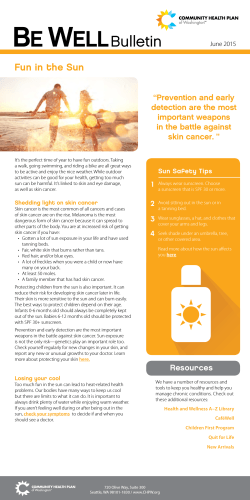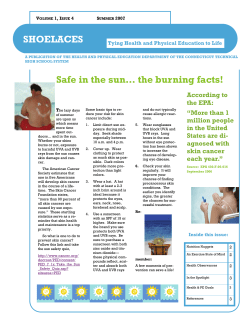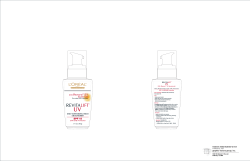
Sunscreen
Sunscreen Sunscreen is one of the most important tools we have to protect our skin from the sun, yet nearly a third of Americans never use it. Too much sun exposure can cause sunburn, premature aging, wrinkles, and in many cases, skin cancer. Unfortunately, many people think that a tan is a healthy look. But what these people don’t know is that a tan is actually like a giant scab that your skin creates to try to protect itself from more sun damage. growing out of control and can lead to skin cancer. Peeling after sunburn is your body’s way of getting rid of damaged cells. Although skin peels and a new skin layer form, some sunburn damage may remain, which causes increased risk of skin cancer. Getting painful sunburn just once every two years can triple the risk of melanoma, the most serious type of skin cancer. What Makes the Sun Harmful? The sun itself is not what harms our skin. It is the ultraviolet (UV) radiation that the sun gives off that actually causes the damage. Ozone layer depletion decreases the atmosphere’s natural protection from harmful UV radiation. Three types of UV rays hit your skin when you are outdoors: UVA, UVB, and UVC. A sunscreen that protects against all three types of UV radiation is the most effective. Forms of Sunscreen There are several factors to consider when choosing a sunscreen product that is right for you. Some factors involve your personal preferences, while others are about the need to protect your skin against the sun’s harmful effects. For example, the form of sunscreen purchased is a personal preference. You can buy sunscreen in many forms: creams, gels, lotions, ointments, and wax sticks – and these are all fine choices. You may want to consider the following information when making your sunscreen selection: UVA rays penetrate deepest into your skin, reaching the new skin that lies far beneath the surface and cause serious damage. These rays are used in tanning booths. UVB rays penetrate about 50 percent farther than UVC rays and are responsible for most of the damage to your skin from sun. • Lotions tend to be less irritating to children, but spray-on and squeeze bottle options are also good. UVC rays stop at your skin’s surface. • Alcohol-based sunscreen products should be avoided on children because they can cause irritation. What Is Sunburn? Sunburn occurs when the sun has damaged the DNA in your skin cells. Damaged DNA can cause cells to start • Choose products that are PABA-free and contain the ingredient titanium dioxide and/or zinc oxide for children and 1 30 deflects 97 percent of the sun’s UVB rays; SPF 15 deflects 93 percent of the sun’s UVB rays, and SPF 2 deflects 50 percent of the sun’s UVB rays. SPF ratings over 30 have not been shown to provide greater protection from the sun’s harmful UV rays than those containing SPF 30. SPF 100 increases the deflection to 99 percent, just 2 percent more than SPF 30. The higher the SPF number, the smaller the difference becomes. No sunscreen provides complete protection. Ideally, all individuals, regardless of skin tone or color, should select a sunscreen with SPF 15 or higher. For children and individuals with very sunsensitive skin, SPF 30 and higher may be warranted. individuals with sensitive skin. Titanium dioxide and zinc oxide physically deflect rather than chemically absorb ultraviolet radiation and, therefore, do not cause allergic reactions. • Creams may work better on the face since gels can sting around the eyes. • Lighter textured sunscreens may work better for those prone to acne (just remember to apply a layer thick enough to protect yourself). • Lip balms with sunscreen rated SPF 15 or higher are an important and necessary form of lip protection. Classification of Sunscreens Sunscreens are classified by the strength of their SPF. SPF ratings can range from minimal (2-11 SPF), to moderate (12-29 SPF), to high (30+ SPF). The SPF number gives you some idea of how long you can stay in the sun without burning. The SPF rating is calculated by comparing the amount of time needed to produce a sunburn on sunscreen-protected skin to the amount of time needed to cause a sunburn on unprotected skin. For example, if a sunscreen is rated SPF 2 and a person who would normally turn red after 10 minutes of sun exposure uses it, it would take 20 minutes of exposure for the skin to turn red. A sunscreen with an SPF of 15 would allow that person to multiply that initial burning time by 15, which means it would take 15 times longer to burn, or 225 minutes (about 3-1/2 hours). This number, however, is imperfect since other factors such as perspiration, humidity, rubbing or toweling off, etc., can all reduce the actual SPF value, and thus, reduce the sunscreen’s effectiveness. It’s in the Ingredients It is very important to find a sunscreen that offers UVA protection in addition to UVB protection. You may see the sunscreen product labeled with the term “broad spectrum” to indicate that it protects against UVA and UVB rays. Sunscreens – even those with the same SPF rating – can have different ingredients or different combinations of ingredients. To be sure the sunscreen protects against UVA radiation, check for any of the following common ingredients: • benzophenones, • oxybenzone, • sulisobenzone, • titanium dioxide, • zinc oxide, • avobenzone (also known as Parsol 1789), or • Mexoryl SX (approved by the U.S. Food and Drug Administration [FDA] July 2006) It is also important to note that SPF ratings do not actually increase proportionately. In other words, an SPF of 30 is not double the protection of an SPF of 15. In fact, an SPF 2 Skin Reactions The first sunscreens relied on a chemical called para-amnobenzoicacid, or PABA. This product irritated many people’s skin, so many sunscreens have changed to milder chemicals. A PABA-free sunscreen is an especially good choice for those with sensitive skin. Additionally, fragrances added to sunscreens can cause allergic reactions in some people who use them. There are fragrance-free alternatives that protect just as well. not appear on the product, write in the date you purchased it. Choosing the Right Sunscreen: Cost Sunscreens can vary in price from a few cents per ounce for generic brands to a few dollars per ounce for designer brands. Studies show that the price of sunscreen is not related to its effectiveness. However, for some high-risk individuals who are especially sensitive to the sun’s rays, cost may make a difference. Often, the sunscreen’s cost suggests a special way that the product was made. For example, a sunscreen made especially for babies may cost more than regular sunscreen, but the difference in price is worth it when you realize that the baby’s sunscreen was created with a special formula that won’t burn if it gets into the baby’s eyes. Water Resistance When choosing a sunscreen, ideally it should be water resistant so that it cannot be easily removed by sweating or swimming. These sunscreens stay on the skin longer even if they get wet, but they are not actually “waterproof” since no product is completely waterproof. Rather, they should be labeled as “water-resistant” or “very water resistant.” In testing procedures, “water-resistant” sunscreen retains its SPF after 40 minutes of sweating/perspiring or water activity; “very water-resistant” sunscreen retains its SPF after 80 minutes (1-1/2 hours) of sweating/ perspiring or water activity. Like other types of sunscreen, water-resistant sunscreens still need to be reapplied often when sweating or swimming, and especially after towel drying when it can be rubbed off. Check the product label for reapplication directions. For most people, however, any sunscreen that contains an FDA-approved sunblocking agent will provide adequate protection. Your best bet is to try out several different products to find the one that works best for you. Putting It on Like many other products, part of sunscreen’s effectiveness is related to how it is used. Sunscreen works best when applied about 30 minutes before you head outside. Apply sunscreen generously, and smooth it on lightly with your fingertips. Then allow it to dry before you put on clothes so that it doesn’t have a chance to rub off. Some sunscreens will stain clothing, so it is a good idea to allow the sunscreen to dry completely before dressing. Sunscreens Do Expire Unless indicated by an expiration date on the product, the FDA requires that all sunscreens be stable at their original strength for at least three years. While you can use the bottle of sunscreen you bought last year, if you are using the recommended amount and are applying it as frequently as instructed, a bottle of sunscreen should not last you very long. If an expiration date does One of the biggest mistakes we make when it comes to sunscreen use is that we don’t use enough. To get the maximum protection from sunscreen, one ounce – one large handful – is the amount needed to properly cover the exposed areas of the body. Think 3 about the areas of your body that are exposed to the sun. In the summertime, even more areas are exposed when wearing shorts, short sleeves, or swimming suits. Use sunscreen liberally, uniformly, and thickly to cover all exposed areas. Pay special attention to covering the face, ears, and neck so as not to miss a spot. A missed area can mean a patchy area of painful sunburn and uneven tanning. Use a lip balm with sunscreen SPF 15 or higher to avoid damage to the lips. And don’t forget to wear sunglasses for eye protection; research has shown that long hours in the sun without protecting your eyes increase your chances of developing eye disease. UV-blocking sunglasses can help protect your eyes from sun damage. sunscreen if you are planning on spending an extended amount of time outdoors. Sunscreen should be reapplied at least every two hours. If activities involve water or heavy perspiration, a water-resistant sunscreen is recommended. Remember, you will still need to reapply sunscreen every two hours or more often if you towel dry or rub off the sunscreen in any way. It isn’t smart to broil in the sun for long periods of time, so seek shade whenever possible, and remember to avoid the sun between 10 a.m and 4 p.m. when the UV rays are strongest. Using sun-protective clothing is highly recommended when planning outdoor events such as boating, fishing, tubing, hiking, etc. Even drivers should wear sunscreen as the UV rays do pass through car windows. Driving during peak sun hours (10:00 a.m. to 4:00 p.m.) calls for applying sunscreen. Tanning pills and accelerators. Tanning pills contain color additives similar to beta-carotene, the substance that gives carrots their orange color. The additives are distributed throughout the body, especially the skin, turning it an orangelike color. Although the FDA has approved some of these additives for coloring food, they are not approved for use in tanning agents. They may be harmful at the high levels that are consumed in tanning pills. The main ingredient in sunless tanning pills, canthaxanthin, can show up in your eyes as yellow crystals, which may cause injury and impaired vision. There have also been reports of liver and skin problems. Many manufacturers recommend using sunscreen every day. This is a good idea since we are all exposed to the sun’s rays, even on cloudy or cold days. However, there are moisturizing lotions, cosmetics, and lipsticks/balms that contain sunscreen. In many cases, these products have a high enough SPF factor to protect you on a daily basis, so you only have to apply regular Tanning accelerators, such as lotions or pills that contain the amino acid tyrosine or its derivatives, are not effective and may be dangerous. Marketers promote these products as substances that stimulate the body’s own tanning process, although most evidence suggests they don’t work. Artificial Tanning The American Cancer Society warns against two types of artificial tanning – tanning beds or sunlamps – and a new product on the market – tanning pills and accelerators. Tanning Beds/Sunlamps. Many people believe the UV rays of tanning beds are harmless. This is not true. Tanning lamps give out UVA and frequently UVB rays as well. Both UVA and UVB rays can cause serious, long-term skin damage. Both contribute to skin cancer. Because of these dangers, many health experts advise people to avoid sunlamps and tanning beds. 4 The FDA considers these unapproved new drugs that have not been shown to be safe and effective. No tanning pills have been approved by the FDA. American Cancer Society. What about Tanning Pills and Other Tanning Products? American Cancer Society. http://www.cancer.org/Cancer/CancerCause s/SunandUVExposure/SkinCancerPreventio nandEarlyDetection/skin-cancer-preventionand-early-detection-tanning-pills-andproducts. Accessed March 2, 2010. Bronzers and Extenders Bronzers, made from color additives approved by the FDA for cosmetic use, stain the skin for a short time when applied and can be washed off with soap and water. Consumer Reports. CR Poll: Thirty-One Percent of Americans Never Use Sunscreen, May 20, 2009. http://pressroom.consumerreports.org/pressr oom/2009/05/consumer-reports-poll-thirtyone-percent-of-americans-never-usesunscreen.html. Extenders (also known as sunless tanners or self-tanners) are applied to the skin as lotions or creams, where they interact with protein on the surface of the skin to produce color. Like a tan, the color tends to wear off after a few days. The only FDA-approved color additive for extenders is dihydroxyacetone (DHA). Because application of these products can sometimes lead to uneven coloring, some tanning salons have begun to offer whole body sprays in tanning booths. A concern here is that DHA is approved for external use only and should not be sprayed in or on the mouth, eyes, or nose. People who choose to get a DHA spray should make sure to protect these areas. Consumer Reports. Sunscreen. July 2009. http://www.consumerreports.org/cro/magazi ne-archive/july-2009/july-2009-toc.htm. Environmental Protection Agency. SunWise Program Health Effects of Overexposure to the Sun. http://www.epa.gov/sunwise/uvandhealth.ht ml. Food and Drug Administration. Sun Safety – Save Your Skin. June 2010. http://www.fda.gov/downloads/ForConsume rs/ConsumerUpdates/UCM143731.pdf. These products do not protect you from UV radiation. Food and Drug Administration. Tanning Products Regulated as Cosmetics. http://www.fda.gov/Cosmetics/ProductandIn gredientSafety/ProductInformation/ucm1340 59.htm. References American Cancer Society. How Do I Protect Myself from UV rays? http://www.cancer.org/Cancer/CancerCause s/SunandUVExposure/SkinCancerPreventio nandEarlyDetection/skin-cancer-preventionand-early-detection-u-v-protection. U.S. National Library of Medicine. National Institutes of Health. Sun Exposure. http://www.nlm.nih.gov/medlineplus/sunexp osure.html. Prepared by Courtney J. Schoessow, MPH, Extension Program Specialist–Health, TexasAgriLife Extension Service, December 2005. Updated by Vita Roth, Extension Assistant, Family Development and Resource Management, Texas AgriLife Extension Service, March 2010. Educational programs of the Texas AgriLife Extension Service are open to all people without regard to race, color, sex, disability, religion, age, or national origin. The Texas A&M University System, U.S. Department of Agriculture, and the County Commissioners Courts of Texas Cooperating 5
© Copyright 2025












